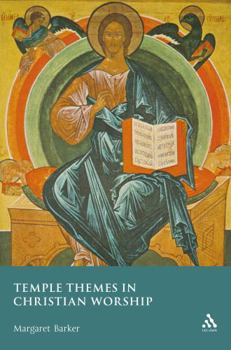Temple Themes in Christian Worship
For a long time scholarship has been seeking the origins of Christian worship in the synagogue. In this new major book, Margaret Barker traces the roots of Christian worship back to the Jewish temple. By proposing a temple setting, a great deal more can be explained, and the existing rather limited resources can be more fruitfully used. By working with a great variety of sources (canonical, extra-canonical and Fathers, all presented here in tranlsation),...
Format:Paperback
Language:English
ISBN:0567032760
ISBN13:9780567032768
Release Date:March 2008
Publisher:T&T Clark
Length:304 Pages
Weight:1.10 lbs.
Dimensions:0.9" x 6.3" x 9.1"
Customer Reviews
2 ratings
A Revolution in Christian Studies
Published by Thriftbooks.com User , 14 years ago
Once in a very great while, a scholar will develop an entirely new explanation for an historical period whose ground had been plowed many times. Is there anything left to discover about the early Christian church? In the case of "Temple Themes in Christian Worship" the answer is a resounding "yes." Margaret Barker's work bids well to revolutionize studies in this field.
A New Understanding of Ancient Rituals
Published by Thriftbooks.com User , 15 years ago
My only criticism of this book is that it repeats many of the ideas in the author's previous books. Some of this material may be redundant to Christians brought up in the Orthodox traditions, but to Protestant Christians like myself, prepare to be enlightened. When we sing the old hymn, "give me that old time religion", we may have to look to the Orthodox traditions of the eastern churches to find it. I still feel that the Reformation was necessary, but when Protestants did away with the liturgy and replaced the Eucharist with the preacher man and his sermon as the focal point of the worship service, they threw the baby out with the dirty bath water. The earliest Christian worship was modelled on the rituals and beliefs of an earlier form of Jewish Temple rituals which predated the Babylonian exile and which was still practiced by cetain Jewish sects into the first century. Barker explains why there is such a rift between modern Rabbinic Judaism and Christianity. Christianity was not a Hellenized form of Messianic Judaism, but preserves an older form of Judaism which the Jewish reformers all but obliterated when the second Temple was built. Fragments of this ancient "First Temple" Judaism can be found in the Psalms, Ezekiel's chariot vision, Isaiah's throne vision and suffering servant, Daniel's Son of Man vision,and Jewish apocalyptic writings and non-canonical books such as Enoch, The Ascension of Isaiah, Jubilees, and the Dead Sea Scrolls. In this form of Judaism, Yahweh, the Lord of Israel, could be seen face to face. Human beings could be resurrected by ascending to Heaven and transformed into angels. Yahweh could be incarnate in a human being who had undergone such a heavenly transformation and could be seated at the right hand of God. This was, no doubt, Jesus' own self-understanding which is why he is worshipped by Christians. Jesus took the Temple rituals and made them his own. Christians worship Jesus as the Lord because Jesus believed this about himself. In ancient Israel, kings were anointed and became royal high priests, Sons of God, modelled after the Heavenly high priest, Melchizedek. The Temple was modelled after the universe with the Holy of Holies representing Heaven itself. When the High Priest entered the Holy of Holies on the Day of Atonement, he wore the name of the Lord and, in a sense, was transformed into the Lord and thus worshipped in that capacity. While reaffirming the rituals of the liturgy, Barker challenges many of what we were taught in Sunday school and by our pastors. Baptism was modeled after the initiation ceremony of the High Priest whereby the High Priest was anointed and transformed into a divine being. The Eucharist was not modeled after the Passover meal but the Day of Atonement ritual which restored the ancient covenant. The priests consumed the uncooked portion of the sacrifice, ie the blood, as a sin offering, to bear the sins of the world. The bread can be traced to the Bread of the P




